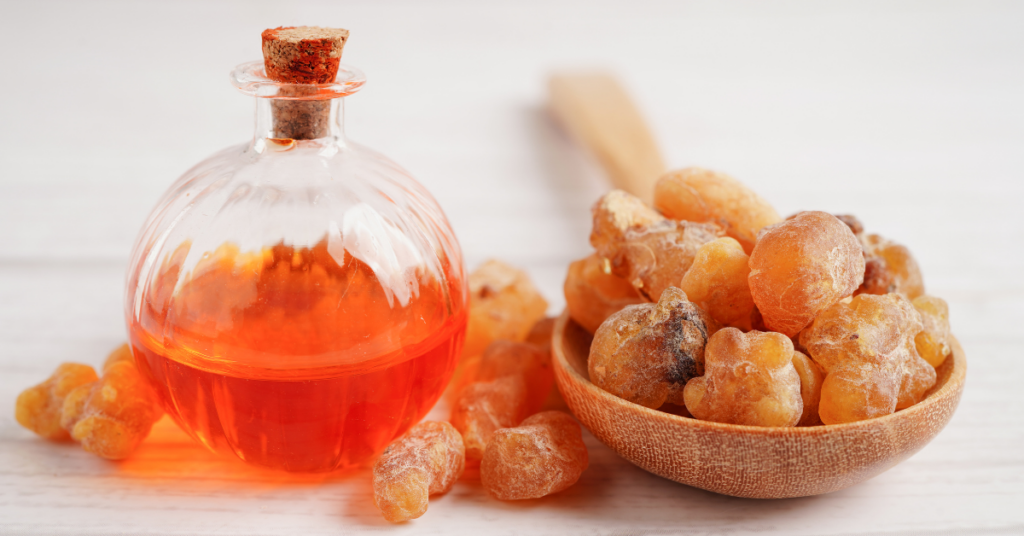Myrrh – Essential Oil
Myrrh (Commiphora myrrha)
The word myrrh corresponds to the Arabic word ‘m-r-r’, which means ‘bitter’, and myrrh oil has been used throughout history in medicinal remedies, incenses, and perfumes.
It is said that the Greek soldiers would not go into battle without a poultice of myrrh to put on their wounds. It is often used in toothpastes and for air purification. However, it tends not to dissolve very well in water.
Uses include:
Stress / depression
Weepy eczema
Athlete’s foot
Cracked skin
Thrush
Gum disorders
Diarrhoea
Respiratory problems
Cautions
Do not use on babies or children under the age of 12 years old.
Do not swallow solution if using the mouthwash.
Stress / depression
Directions for use
Handkerchief: Put a couple of drops of pure essential oil onto a tissue or handkerchief and inhale as and when required.
Massage: Mix 20 ml of carrier oil (sweet almond, grape seed) to 10 drops of pure essential oil.
Oil burners: Sprinkle up to 5 drops of pure essential oil onto water and light the burner.
Inhalation: Boil 1 litre of water and pour into a bowl, add up to 10 drops of pure essential oil, place a towel over your head and allow steam to rise and inhale.
Weepy eczema
Directions for use
Compress: Add 1-2 drops of pure essential oil to 1 litre of warm water. Lay sterile material on the surface of the water thus attracting a film of oil onto the cloth. Apply the material onto the affected area and leave for 10 minutes. Repeat daily.
Massage: Mix 1 drop of pure essential oil to 2 teaspoons of almond or grape seed oil, or any other carrier oil and rub into affected area.
Athlete’s foot
Directions for use
Massage: Mix 20ml of carrier oil (sweet almond, grapeseed) to 10 drops of pure essential oil.
Oil burners: Sprinkle up to five drops of pure essential oil onto water and light the burner.
Footbath: Put 3 drops of oil in bowl of warm/ hot water and soak feet for up to fifteen minutes.
Cracked skin
Directions for use
Bath: Add up to 5 drops of pure essential oil to a bath of water and lie back and relax.
Massage: Mix 20 ml of carrier oil (sweet almond, grape seed) to 10 drops of pure essential oil.
Ointments: Add a drop of oil to moistures and rub into feet.
Footbath: Put 3 drops of oil in bowl of warm or hot water and soak feet for up to 15 minutes.
Thrush
This oil has anti-fungal properties.
Directions for use
Douche: Add a drop to the water.
Massage: Mix 20 ml of carrier oil (sweet almond, grape seed) to 10 drops of pure essential oil.
Gum disorders
Although myrrh tastes very bitter, it is an excellent treatment for conditions to do with the mouth, such as ulcers, bleeding gums and oral thrush.
Directions for use
Use tincture of myrrh.
Diarrhoea
Directions for use
Massage: Mix 20 ml of carrier oil (sweet almond, grape seed) to 10 drops of pure essential oil and massage into abdominal area in a clockwise direction.
Respiratory problems
Acts on catarrh and chronic bronchitis, it is a great oil to use if you are suffering from a cold as it is an antiseptic.
Directions for use
Handkerchief: Put a couple of drops of pure essential oil onto a tissue or handkerchief and inhale as and when required.
Massage: Mix 20 ml of carrier oil (sweet almond, grape seed) to 10 drops of pure essential oil.
Oil burners: Sprinkle up to 5 drops of pure essential oil onto water and light burner.
Inhalation: Boil 1 litre of water and pour into a bowl, add up to 10 drops of pure essential oil, place a towel over your head and allow steam to rise and inhale.
Further Information
Where grown: Myrrh comes from a shrub that grows up to 9 metres tall and grows in Somalia and Ethiopia, regions of Libya, Iran, along the Red Sea. It belongs to the Burseraceae family, which is the family that Frankincense belongs to.
Parts used and method of extraction: By cutting into the tree a resin seeps out and forms a gum – a solid mass reddish in colour. The oil is extracted by a process of steam distillation.
Colour and smell: The oil is a dark amber in colour although some oils can be really pale. The oil is sometimes mixed with alcohol, like benzoin, to make it less viscous and easier to use.
Active ingredients: Limonene, eugenol, dipentene, pinene, cadinene, acetic acid, a number of resins, myrrholic acid and cinnamaldehyde.
Properties: Antiseptic, anti-inflammatory, analgesic, fungicidal, anti-catarrh, stimulating (digestive system).
Mixes well with: Cypress, frankincense, lavender, bergamot, sandalwood, geranium, ylang ylang, lemon, and many others.

